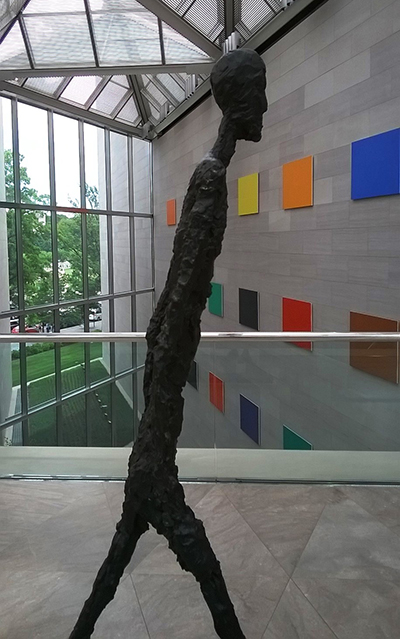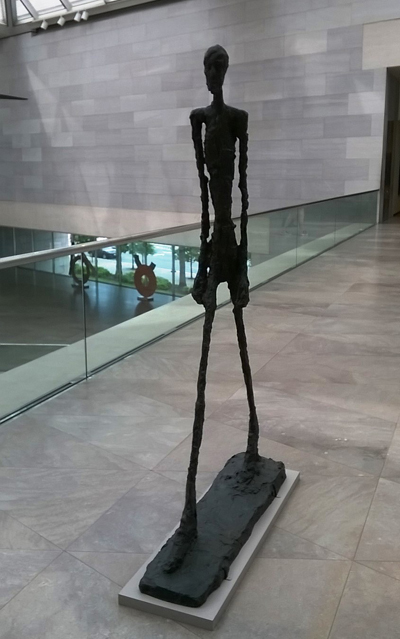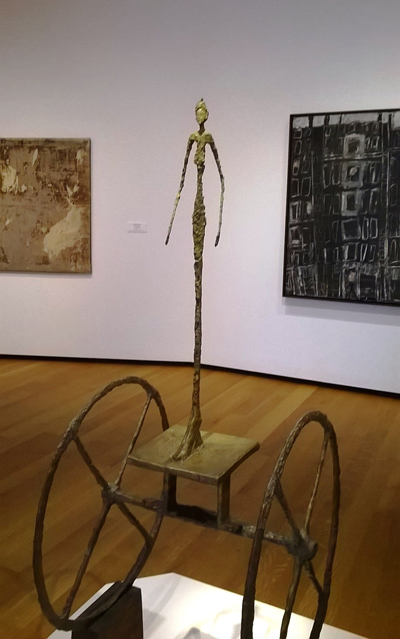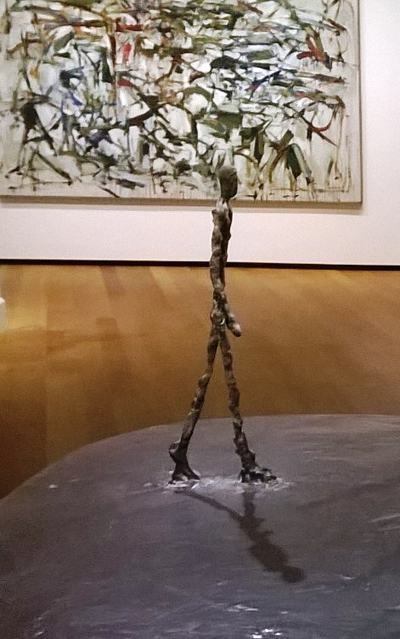Looking Again at Giacometti
Daniel Barbiero
September 2017
 Walking Man II, photo courtesy of the author
Walking Man II, photo courtesy of the author
With a retrospective of his work running this summer at the Tate Modern in London, Alberto Giacometti, a sculptor whose strangely elongated figures came to symbolize the mood of the postwar period, came back to mind. In July I went to the East Wing of the National Gallery of Art to look again at his work.
For a time in the 1950s and 1960s, Alberto Giacometti’s mature sculptures—spindly bronze figures with rough, pitted surfaces—were taken as emblems of the psychological dislocations brought on by the horrors of the recently ended Second World War. Giacometti’s work was particularly associated with postwar Existentialism—an association quite naturally reinforced by Sartre’s substantial introductory essay to a 1948 show of the sculptures. The interpretation of Giacometti’s thin—emaciated, I suppose, if one wants to see them that way—figures in terms of a postwar atmosphere of anxiety and alienation became something of a standard, exemplified by, for example, William Barrett’s exegesis in his book Irrational Man, at least one edition of which put an image of a Giacometti Walking Man on its cover. But it was an association that Giacometti didn’t like, according to the philosopher Arthur Danto, who knew him. And yet it’s hard to dissociate them completely from the period; they became, as we now would say, iconic. To look at them is, to some extent, to be reminded of a past whose preoccupations aren’t ours. But because those preoccupations don’t belong to us, we can look again at the sculptures and see them for what Giacometti imagined them to be: Simply artifacts of the world as it appears.
“I have enough trouble with the outside without bothering about the inside”
Giacometti’s postwar sculptures were of three major types: Figures of men walking, figures of women standing, and heads. There were some variations–for example, a sculpture depicting a man falling, a male figure pointing, a disembodied head. All share a certain stylized look, a kind of reductive abstraction that renders the body as a scaffolding and recalls archaic sculpture. Take, for example, The Chariot of 1950. The sculpture consists of a large pair of wheels joined by a narrow axle on top of which is a platform supporting the elongated figure of a woman. She is facing front, arms down and hands pressed against her hips seemingly in order to minimize any deviation from the vertical axis. The pose emphasizes the flatness of the front and the linearity of the side. In contrast to the static composition of The Chariot, the well-known Walking Man II (1960) is a dynamically-portrayed bronze stick figure whose posture—bent forward and frozen in the moment of a long stride—implies a rapid, purposeful pace.
As with Giacometti’s other figures these are gracile, but they exhibit an unexpected ruggedness. Close up, they show themselves to be composed of lumps and blobs of matter forming a roughly discontinuous surface more akin to the scree at the foot of a ridge than to the human figure with its defined musculature and expressively elastic facial features. These harsh, unfinished-looking surfaces were deliberate and meant to communicate that the sculpture had “no pretensions to being a finished statement.”
Although the limbs and torsos of Giacometti’s walking men and standing women are remarkable for their thinness, the figures themselves don’t appear frail. Their postures–frozen at the moment one foot is put in front of the other, or standing stiffly upright with weight evenly distributed as if supporting a lintel–somehow communicate balance even if initially they seem of uncertain ability to bear their own weight. These figures are thin but solid—a compact mass paradoxically stretched to the point of appearing to want to dissolve. But they don’t dissolve. Instead, there is an odd density to them. Their implication of great mass compressed into a small physical space recalls the density of a neutron star, a teaspoon of which would weigh a billion tons.
Seen from the front, Giacometti’s figures—their torsos, specifically–exhibit a marked planarity or flatness. This is in contrast to the view from the side, which reveals a more linear look. In geometric terms, what Giacometti does here is mimic the two-dimensionality of the plane with the front view, and the one-dimensionality of the line with the side view. But there is also an echo of Cycladic sculpture, the stylized forms of which Giacometti frequently acknowledged as an important influence. Curiously, Giacometti saw stylized depictions of things—human and animal figures, inanimate objects such as trees—to be more like the things depicted than more realistic or illusionistic depictions. As examples of this “more like” manner of depiction, he cited Egyptian or Byzantine painting. This may be tied to his central project of rendering visibility visible, that is, showing how we see by showing what we see, as presented under a certain aspect. For Giacometti that aspect generally consisted in the figure seen frontally and from a distance, which would present the viewer with a seemingly flat surface.
Giacometti’s mature style evolved out of tiny sculptures he had been making while in Switzerland during the war. Back in Paris around 1946, he began enlarging his figures at least in height; as he did so, they became thinner and took on the look his work was to become known for. He was trying to give them a look of lightness that he associated with the way the human figure actually appears in life, his idea being that in reality people have a certain lightness on their feet that sculpture should somehow capture. His solution was to reduce the sculpted figure’s bulk along the horizontal, while retaining its reach along the vertical.
But the thinness of the figures may also have been connected to a strange episode that occurred around this time. In 1945 or 1946—it isn’t exactly clear when—Giacometti underwent some type of crisis that he described in various ways to different people over the years. Like its time of occurrence the exact nature of what happened is somewhat obscure, but the upshot seems to have been a shift in his way of seeing things. Objects around him lost their ordinary meanings and became “marvelous,” or “separated by immeasurable chasms of emptiness” or else imbued with a lightness and radical separation from each other—a kind of weightlessness. (Curiously, there seems to be an odd, if inverted, resemblance to the famous scene in Nauseau where Roquentin suddenly and traumatically faces the world in all its gratuitous plenitude. For Giacometti, the over-muchness of being that unsettled Roquentin is replaced by an equally unsettling paucity.) According to the critic Harold Rosenberg, Giacometti later explained his figures’ thinness in terms of weightlessness.
“Of the work of all those [Surrealist] years I can say only that I did it because it was so easy.”
The mature sculptures represent a significant break from the Surrealist sculpture that first brought Giacometti recognition in the early 1930s. These earlier works, such as The palace at 4 am, put otherworldly shapes in strange combinations and hint at an uncanny narrative whose specific events and characters remain obscure. During this time Giacometti tried to make art that would exactly portray something he imagined—it would be a transcription in three dimensions of something “seen” in the mind. He described this as “an exercise” to determine if in fact the mind’s eye really could see in detail, or whether this kind of inner “vision” was something vague that would change over the course of its being translated into an external object. The palace at 4 am was one such transcription, and one that he thought was successful.
Giacometti was involved with the Surrealist group only for a relatively brief time—from 1930 until 1934. In retrospect, he described his experience with them as a “transitional;” although the work he did under Surrealism’s auspices was well-regarded, he tended to dismiss these exercises in transcribing what he had imagined as “so easy” and to downplay the significance of Surrealism as such in relation to his own development. He explained his attraction to Surrealism as having been part of a larger attraction to different types of modern art in general, including abstract art. It’s worth noting that the archaic and exotic art that he was drawn to was held in high regard by Surrealism as well; André Breton, the group’s leader, was an avid collector of art from Central and South America, Africa and Oceania, as were others in his circle. Beyond this coincidence of tastes, Giacometti acknowledged that he shared the Surrealist belief in what he described as “the importance of the subject,” which is to say that what was depicted was just as important as the way it was depicted. This he contrasted with Cubism’s preoccupation with exploring and expanding the formal language of visual art, which he felt reduced the subject being depicted to simply a pretext for exploring the ways it could be depicted. But Surrealism’s interest in subject matter came with its own set of restrictions. Working from life ran against Surrealist dogma, and when Giacometti showed interest in working from a live model he was excommunicated from the group.
The postwar work, in contrast to the Surrealist work, eschewed ambiguous objects and situations for the human figure. It took Giacometti from the realm of the purely imaginary to an imagining of the empirical.
“That’s exactly what I’m trying to do—to show how things appear to me.”
“Their content is not only the what but also the how of visual experience: their subject is not only what we see, but also the act of seeing.”
–David Sylvester on Giacometti’s mature sculptures
The visual imagination of the empirical begins with space. Space is itself a cognitive framework that allows us to represent things as being in relation to us independently of us. Kant described it as the “subjective condition of all external phenomena,” that is, the mental basis for perceiving a world outside of us. Through it we organize the world of visual perception in a certain way: as having the qualities of three dimensionality, continuity and infinite extension. Such a framework is a precondition for perceiving external objects—sculptures among them–generally. But what does this have to do with Giacometti’s sculptures specifically?
Space is the implicit subject of the standing and walking sculptures. By depicting these figures as he does, Giacometti implies the space surrounding them, even when they are presented singly rather than in groups. The groups make space explicitly present in that one can look between the figures and see the space that they define and that defines them reciprocally. With the single figures, the matter is handled more subtly.
 Walking Man II, photo courtesy of the author
Walking Man II, photo courtesy of the author
Take Walking Man II. Thrusting itself forward, the figure is an eruption of a thin wedge of mass into space, which it separates by virtue of its intrusion. There is a clear delineation between mass and space; that delineation just is the angled line of the figure as it separates expanses of space—a dull knife-edge bluntly parting a transparent curtain to disclose a contrast between emptiness of space—space as an empty frame we construct—and solidity of the body. The Walking Man’s body exhibits a physical intentionality, an “aboutness” or directedness aimed at the surrounding space. He projects himself into space. And yet in both enveloping and separating his narrow trunk and limbs, space somehow projects back. The relationship between space and figure is reciprocal, turning as it does on a kind of physical dialectic between the body’s projecting outward and the unseen, unfelt reception of that projection in and by space. It is in this unseen and unfelt reception that space, as a plastic element, consists.
With Walking Man II, as with his other individual figures, Giacometti sets up a peculiar kind of friction—a conceptual friction whereby the projecting volume of the body is met not by the kind of physical resistance it would had it encountered another solid object, but by a kind of plastic accommodation through which it is situated as being here, a figure against this particular ground. Space is in this regard a determination of being in that it localizes and circumscribes an object, giving it definition as a being in all its peculiarity.
But at the same time, space is a phenomenon that we tend to experience as a neutral nothingness, to the extent that we even can be said to experience it as something meriting our attention at all. Instead, space ordinarily functions as an assumed background that rarely rises to the level of reflection. But here, partly by virtue of Walking Man’s apparent insubstantiality, space becomes dominant and takes on a compensating substantiality. We no longer encounter it as a transparent nothingness surrounding the objects that populate it but instead become conscious of it as a constitutive framework through which objects can be confronted. We encounter it as a cognitive tool making the world intelligible. In sum, we can say that this figure, by throwing the plasticity of space into high relief, thematizes space and brings it to explicit attention. In doing so, it ties space into the act of seeing and discloses space as something like the constitutive ground of seeing, thereby making the conditions undergirding seeing visible. (This same observation can be made for Giacometti’s other mature standing, walking, falling and pointing figures.)
 The Chariot, photo courtesy of the author
The Chariot, photo courtesy of the author
“…at that distance they simply become appearances”
One way of encountering perceptual space is as distance. Space, as the cognitive organization of objects around us, introduces distance as a sometimes rough, experiential means of measurement. Space organizes the visual field into a gestalt of foreground and background, distance and proximity—terms that make sense only in relation to each other and ultimately only in relation to an observer. Giacometti grasped this with vigor. His figures were meant to seem distant no matter how close up the viewer stands. Sometimes the distance was an illusory one in which the figure was intended to create the sense of having been seen from far off. In other cases it was calculated quite literally, as apparently it was for The Chariot. In his notes on that piece, published in the catalogue to his November, 1950 show at the Pierre Matisse Gallery in New York, Giacometti explained that the figure was made to be viewed at a “precise distance” from the floor.
Giacometti seems to have elongated his figures in order to simulate what he thought a person would look like at a given distance, his or her mass apparently reduced to an essential core tightly bound to the vertical axis running from the top of the head to the sole of the foot. Everything outside of that core is made to melt into air, leaving behind a skeletal residue that Giacometti recreated as sculpture. The space surrounding the sculpture is the measure of distance; distance in turn distorts the figure, gives it to us as line or plane, disguises it as an indecipherable mass or an otherwise ambiguous object. (Distance is odd in that it disguises even as it discloses.)
It’s possible to see Giacometti’s standing and walking figures as tests of a perceptual hypothesis: At a certain distance, does the mind “unsee” the figure as a solid unity and reduce it to a play of shapes and surfaces? When I see a standing or walking figure from far away, I can make out a head and torso; depending on the angle, I might also see arms or legs as separate protrusions jutting out from the vertical axis. Other details—facial expression, the cut of the clothes, the splay of the fingers—remain obscure. Whether or not I see the distant figure as the slender and elongated body that Giacometti apparently saw, what I’m often left with is the sight of an aggregation of lines and planes—a kind of abstract object that exists for me as an exteriority or opaque surface behind which lies something to be speculated about or indifferent to. The play of the surface, which is all that someone really sees of us at a distance, is the play of mute presence. It’s tempting to ascribe this indeterminacy to something deeper than perception, to describe it as a contradiction within being to the extent that here is a specific being none of whose specificity can be read and who instead dissolves into a generic set of features common to a species. But it is only a fact, or rather an artifact, of perception.
Or of misperception, the creative potential of which can be surprising. In fact, one of Giacometti’s sculptures, a group of seven figures and a bust, was directly inspired by a creative misperception he’d had. The sculpture “reminded me of the corner in a forest, seen over many years (during my childhood), where trees with bare slender trunks, limbless almost to the top (and behind which granite boulders could be seen), always looked to me like people stopped dead in their tracks and talking among themselves.” This sounds like an approximate description of Giacometti’s City Square of 1948, which depicts the tree-like figures of five men frozen in mid-step. But the description of human figures’ resemblance to “bare slender trunks” holds as well for Giacometti’s mature sculptures generally. They do resemble bare branches and twigs or thin trunks supported by narrow roots.
 City Square, photo courtesy of the author
City Square, photo courtesy of the author
As noted above, Giacometti’s evocation of Cycladic sculpture is a matter of influence, but it is also a way of creating an illusion. The illusion is one of perspective—of perception from a given place at a given remove from its object. Perspective is something that only arises in relation to a situated observer—it is the opposite and as such is to some degree the refutation of the view sub specie aeternitatis, which is to say the all-encompassing view from nowhere in particular. The embodied perspective, in other words, is a feature of concrete existence before it is abstracted away into a theoretical construct containing all perspectives simultaneously. This return to the concrete is a core tenet of the existentialist outlook, but it’s also possible that Giacometti’s simulation of perspective from a distance was a factor in the “existentialist” interpretation of his work. Consider how easily the figure seen at a distance can be couched in the dialectical terms of the existentialist analysis of self and other. At a distance, one is apprehended as a particular kind of pure presence—as an object more or less inert in its presence, which is to say without reference to its possibilities. One just “is there” as a thing complete in its opacity, without possibilities or potentials to realize, without being in motion toward an aim or desired future state. In other words, not as a finite yet dynamic complex of projects and preoccupations reaching toward an open—because as yet undetermined—future.
In the end, the critic David Sylvester’s claim that “Giacometti objectifies the conditions under which he has seen it—the fact that it is seen in space, the fact that it is uncertain where the boundary is between solid forms and space…the fact that it was seen at a certain distance” would seem to be right. Giacometti’s fundamental subject matter would seem to have been the object as it is presented to consciousness under a given aspect. The thing as phenomenon—not the thing in itself (whatever that may be) but the thing as it is for us.
